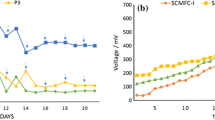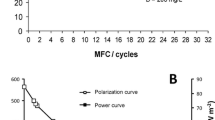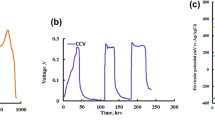Abstract
Polycyclic aromatic hydrocarbons have attracted considerable attention for their carcinogenic, teratogenic, and mutagenic properties in humans. Phenanthrene is one of the most abundant polycyclic aromatic hydrocarbons in aquatic environments. In this study, different concentrations of phenanthrene were degraded by single-chamber air-cathode microbial fuel cells. The electrochemical parameter of microbial fuel cells and biofilm changes on the anode were observed. The results showed that the addition of phenanthrene reduced the power output of the microbial fuel cell which affected the process of microbial electricity generation. Meanwhile, microorganisms destroyed the original structure of phenanthrene through anaerobic metabolism, and achieved good average degradation of 94.9–98.4%. Observation of the anodic biofilm found that the microbes had tolerance to phenanthrene and the biofilm exhibited to be well-constructed. Bacterial community distribution showed a decrease in the relative abundance of Acidovorax and Aquamicrobium, whereas the relative content of the main electroactive organism, Geobacter, increased by a factor of three. The results show that it is feasible for microbial fuel cells to biodegrade phenanthrene, and provide some references for the changes of microbial community during degradation process.
Graphical abstract






Similar content being viewed by others
Data availability
Not applicable.
References
Abd Manan TSB, Khan T, Sivapalan S, Jusoh H, Sapari N, Sarwono A, Ramli RM, Harimurti S, Beddu S, Sadon SN, Kamal NLM, Malakahmad A (2019) Application of response surface methodology for the optimization of polycyclic aromatic hydrocarbons degradation from potable water using photo-Fenton oxidation process. Sci Total Environ 665:196–212. https://doi.org/10.1016/j.scitotenv.2019.02.060
Adelaja O, Keshavarz T, Kyazze G (2014) Enhanced biodegradation of phenanthrene using different inoculum types in a microbial fuel cell. Eng Life Sci 14(2):218–228. https://doi.org/10.1002/elsc.201300089
Adelaja O, Keshavarz T, Kyazze G (2015) The effect of salinity, redox mediators and temperature on anaerobic biodegradation of petroleum hydrocarbons in microbial fuel cells. J Hazard Mater 283:211–217. https://doi.org/10.1016/j.jhazmat.2014.08.066
Adelaja O, Keshavarz T, Kyazze G (2017) Treatment of phenanthrene and benzene using microbial fuel cells operated continuously for possible in situ and ex situ applications. Int Biodeterior Biodegradation 116:91–103. https://doi.org/10.1016/j.ibiod.2016.10.021
Bamforth SM, Singleton I (2005) Bioremediation of polycyclic aromatic hydrocarbons: current knowledge and future directions. J Chem Technol Biotechnol 80(7):723–736. https://doi.org/10.1002/jctb.1276
Barra R, Quiroz R, Saez K, Araneda A, Urrutia R, Popp P (2009) Sources of polycyclic aromatic hydrocarbons (PAHs) in sediments of the Biobio River in south central Chile. Environ Chem Lett 7:133–139. https://doi.org/10.1007/s10311-008-0148-z
Bhowmick GD, Noori MT, Das I, Neethu B, Ghangrekar MM, Mitra A (2018) Bismuth doped TiO2 as an excellent photocathode catalyst to enhance the performance of microbial fuel cell. Int J Hydrog Energy 43(15):7501–7510. https://doi.org/10.1016/j.ijhydene.2018.02.188
Bidzhieva SK, Sokolova DS, Tourova TP, Nazina TN (2018) Bacteria of the genus Sphaerochaeta from low-temperature heavy oil reservoirs (Russia). Microbiology 87(6):757–765. https://doi.org/10.1134/S0026261718060048
Bourguignon N, Irazusta V, Isaac P, Estevez C, Maizel D, Ferrero MA (2019) Identification of proteins induced by polycyclic aromatic hydrocarbon and proposal of the phenanthrene catabolic pathway in Amycolatopsis tucumanensis DSM 45259. Ecotoxicol Environ Saf 175:19–28. https://doi.org/10.1016/j.ecoenv.2019.02.071
Chen M, Xu P, Zeng G, Yang C, Huang D, Zhang J (2015) Bioremediation of soils contaminated with polycyclic aromatic hydrocarbons, petroleum, pesticides, chlorophenols and heavy metals by composting: Applications, microbes and future research needs. Biotechnol Adv 33(61):745–755. https://doi.org/10.1016/j.biotechadv.2015.05.003
Chen X, Yang B, Oleszczuk P, Gao Y, Yuan X, Ling W, Waigi MG (2019) Vanadium oxide activates persulfate for degradation of polycyclic aromatic hydrocarbons in aqueous system. Chem Eng J 364:79–88. https://doi.org/10.1016/j.cej.2019.01.117
Cheng S, Liu H, Logan BE (2006) Power densities using different cathode catalysts (Pt and CoTMPP) and polymer binders (Nafion and PTFE) in single chamber microbial fuel cells. Environ Sci Technol 40(1):364–369. https://doi.org/10.1021/es0512071
Choi K, Kondaveeti S, Min B (2017) Bioelectrochemical methane (CH4) production in anaerobic digestion at different supplemental voltages. Bioresour Technol 245:826–832. https://doi.org/10.1016/j.biortech.2017.09.057
Gao S, Seo J, Wang J, Keum Y, Li J, Li QX (2013) Multiple degradation pathways of phenanthrene by Stenotrophomonas maltophilia C6. Int Biodeterior Biodegradation 79:98–104. https://doi.org/10.1016/j.ibiod.2013.01.012
Guo M, Gong Z, Miao R, Jia C, Rookes J, Cahill D, Zhuang J (2018) Enhanced polycyclic aromatic hydrocarbons degradation in rhizosphere soil planted with tall fescue: bacterial community and functional gene expression mechanisms. Chemosphere 212:15–23. https://doi.org/10.1016/j.chemosphere.2018.08.057
Gupta G, Kumar V, Pal AK (2016) Biodegradation of polycyclic aromatic hydrocarbons by microbial consortium: a distinctive approach for decontamination of soil. Soil Sediment Contam 25:597–623. https://doi.org/10.1080/15320383.2016.1190311
Hamdan HZ, Salama DA, Hari AR, Semerjian L, Saikaly P (2017) Assessment of the performance of SMFCs in the bioremediation of PAHs in contaminated marine sediments under different redox conditions and analysis of the associated microbial communities. Sci Total Environ 575:1453–1461. https://doi.org/10.1016/j.scitotenv.2016.09.232
Harrison RM, Smith DJT, Luhana L (1996) Source apportionment of atmospheric polycyclic aromatic hydrocarbons collected from an urban location in Birmingham, U.K. Environ Sci Technol 30:825–832. https://doi.org/10.1021/es950252d
Harwood CS, Burchhardt G, Herrmann H, Fuchs G (1998) Anaerobic metabolism of aromatic compounds via the benzoyl-CoA pathway. FEMS Microbiol Rev 22:439–458. https://doi.org/10.1016/S0168-6445(98)00026-6
Hassan H, Jin B, Donner E, Vasileiadis S, Saint C, Dai S (2018) Microbial community and bioelectrochemical activities in MFC for degrading phenol and producing electricity: Microbial consortia could make differences. Chem Eng J 332:647–657. https://doi.org/10.1016/j.cej.2017.09.114
Hassan SHA, Zohri AENA, Kassim RMF (2019) Electricity generation from sugarcane molasses using microbial fuel cell technologies. Energy 178:538–543. https://doi.org/10.1016/j.energy.2019.04.087
Hua T, Li S, Li F, Ondon BS, Liu Y, Wang H (2019a) Degradation performance and microbial community analysis of microbial electrolysis cells for erythromycin wastewater treatment. Biochem Eng J 146:1–9. https://doi.org/10.1016/j.bej.2019.02.008
Hua T, Li S, Li F, Wang H (2019b) Treatment of naphthalene by microbial electrochemical system and the analysis of microbial communities. Chem J Chin Univ 40:1964–1971. https://doi.org/10.7503/cjcu20190088
Ishii S, Suzuki S, Norden-Krichmar TM, Tenney A, Chain PSG, Scholz MB, Nealson KH, Bretschger O (2013) A novel metatranscriptomic approach to identify gene expression dynamics during extracellular electron transfer. Nat Commun 4:1–10. https://doi.org/10.1038/ncomms2615
Jin X, Guo F, Ma W, Liu Y, Liu H (2019) Heterotrophic anodic denitrification improves carbon removal and electricity recovery efficiency in microbial fuel cells. Chem Eng J 370:527–535. https://doi.org/10.1016/j.cej.2019.03.023
Jiang Y, Zhang B, He C, Shi J, Borthwick AGL, Huang X (2018) Synchronous microbial vanadium (V) reduction and denitrification in groundwater using hydrogen as the sole electron donor. Water Res 141:289–296. https://doi.org/10.1016/j.watres.2018.05.033
Katuri KP, Enright A, O'Flaherty V, Leech D (2012) Microbial analysis of anodic biofilm in a microbial fuel cell using slaughterhouse wastewater. Bioelectrochemistry 87:164–171. https://doi.org/10.1016/j.bioelechem.2011.12.002
Kong F, Sun G, Liu Z (2018) Degradation of polycyclic aromatic hydrocarbons in soil mesocosms by microbial/plant bioaugmentation: performance and mechanism. Chemosphere 198:83–91. https://doi.org/10.1016/j.chemosphere.2018.01.097
Kronenberg M, Trably E, Bernet N, Patureau D (2017) Biodegradation of polycyclic aromatic hydrocarbons: Using microbial bioelectrochemical systems to overcome an impasse. Environ Pollut 231:509–523. https://doi.org/10.1016/j.envpol.2017.08.048
Li S, Hua T, Yuan C, Li B, Zhu X, Li F (2020) Degradation pathways, microbial community and electricity properties analysis of antibiotic sulfamethoxazole by bio-electro-Fenton system. Bioresour Technol 298:122501. https://doi.org/10.1016/j.biortech.2019.122501
Logan BE, Hamelers B, Rozendal RA, Schrorder U, Keller J, Freguia S, Aelterman P, Verstraete W, Rabaey K (2006) Microbial fuel cells: methodology and technology. Environ Sci Technol 40:5181–5192. https://doi.org/10.1021/es0605016
Lu L, Xing D, Ren ZJ (2015) Microbial community structure accompanied with electricity production in a constructed wetland plant microbial fuel cell. Bioresour Technol 195:115–121. https://doi.org/10.1016/j.biortech.2015.05.098
Łyszczek R (2007) Thermal and spectroscopic investigations of new lanthanide complexes with 1,2,4-benzenetricarboxylic acid. J Therm Anal Calorim 90:533–539. https://doi.org/10.1007/s10973-006-7734-8
Milner EM, Popescu D, Curtis T, Head IM, Scott K, Yu EH (2016) Microbial fuel cells with highly active aerobic biocathodes. J Power Sources 324:8–16. https://doi.org/10.1016/j.jpowsour.2016.05.055
Moscoso F, Teijiz I, Deive FJ, Sanroman MA (2012) Efficient PAHs biodegradation by a bacterial consortium at flask and bioreactor scale. Bioresour Technol 119:270–276. https://doi.org/10.1016/j.biortech.2012.05.095
Nastro RA, Gambino E, Toscanesi M, Arienzo M, Ferrara L, Trifuoggi M (2019) Microbial fuel cells (MFCs) remediation activity of marine sediments sampled at a dismissed industrial site: What opportunities? J Clean Prod 235:1559–1566. https://doi.org/10.1016/j.jclepro.2019.07.019
Onwudili JA, Williams PT (2007) Reaction mechanisms for the decomposition of phenanthrene and naphthalene under hydrothermal conditions. J Supercrit Fluids 39:399–408. https://doi.org/10.1016/j.supflu.2006.03.014
Riding MJ, Doick KJ, Martin FL, Jones KC, Semple KT (2013) Chemical measures of bioavailability/bioaccessibility of PAHs in soil: fundamentals to application. J Hazard Mater 261:687–700. https://doi.org/10.1016/j.jhazmat.2013.03.033
Santoro C, Arbizzani C, Erable B, Ieropoulos I (2017) Microbial fuel cells: from fundamentals to applications. A review. J Power Sources 356:225–244. https://doi.org/10.1016/j.jpowsour.2017.03.109
Shi J, Zhang B, Cheng Y, Peng K (2020) Microbial vanadate reduction coupled to co-metabolic phenanthrene biodegradation in groundwater. Water Res 186:116354. https://doi.org/10.1016/j.watres.2020.116354
Srikanth S, Kumar M, Singh D, Singh MP, Das BP (2016) Electro-biocatalytic treatment of petroleum refinery wastewater using microbial fuel cell (MFC) in continuous mode operation. Bioresour Technol 221:70–77. https://doi.org/10.1016/j.biortech.2016.09.034
Stingley RL, Khan AA, Cerniglia CE (2004) Molecular characterization of a phenanthrene degradation pathway in Mycobacterium vanbaalenii PYR-1. Biochem Bioph Res Communications 322:133–146. https://doi.org/10.1016/j.bbrc.2004.07.089
Sun G, Kang K, Qiu L, Guo X, Zhu M (2019) Electrochemical performance and microbial community analysis in air cathode microbial fuel cells fuelled with pyroligneous liquor. Bioelectrochemistry 126:12–19. https://doi.org/10.1016/j.bioelechem.2018.11.006
Wang J, Song X, Li Q, Bai H, Zhu C, Weng B, Yan D, Bai J (2019) Bioenergy generation and degradation pathway of phenanthrene and anthracene in a constructed wetland-microbial fuel cell with an anode amended with nZVI. Water Res 150:340–348. https://doi.org/10.1016/j.watres.2018.11.075
Xu G, Zheng X, Lu Y, Liu G, Luo H, Li X, Zhang R, Jin S (2019) Development of microbial community within the cathodic biofilm of single-chamber air-cathode microbial fuel cell. Sci Total Environ 665:641–648. https://doi.org/10.1016/j.scitotenv.2019.02.175
Xue W, Zhou Q, Li F, Ondon BS (2019) Zeolitic imidazolate framework-8 (ZIF-8) as robust catalyst for oxygen reduction reaction in microbial fuel cells. J Power Sources 423:9–17. https://doi.org/10.1016/j.jpowsour.2019.03.017
Yan Z, Song N, Cai H, Tay J, Jiang H (2012) Enhanced degradation of phenanthrene and pyrene in freshwater sediments by combined employment of sediment microbial fuel cell and amorphous ferric hydroxide. J Hazard Mater 199:217–225. https://doi.org/10.1016/j.jhazmat.2011.10.087
Ye Q, Zhang Z, Huang Y, Fang T, Cui Q, He C, Wang H (2018) Enhancing electron transfer by magnetite during phenanthrene anaerobic methanogenic degradation. Int Biodeterior Biodegradation 129:109–116. https://doi.org/10.1016/j.ibiod.2018.01.012
Yilmazel YD, Zhu X, Kim K, Holmes DE, Logan BE (2018) Electrical current generation in microbial electrolysis cells by hyperthermophilic archaea Ferroglobus placidus and Geoglobus ahangari. Bioelectrochemistry 119:142–149. https://doi.org/10.1016/j.bioelechem.2017.09.012
Yu B, Tian J, Feng L (2017) Remediation of PAH polluted soils using a soil microbial fuel cell: Influence of electrode interval and role of microbial community. J Hazard Mater 336:110–118. https://doi.org/10.1016/j.jhazmat.2017.04.066
Zhang B, Feng C, Ni J, Zhang J, Huang W (2012) Simultaneous reduction of vanadium (V) and chromium (VI) with enhanced energy recovery based on microbial fuel cell technology. J Power Sources 204:34–39. https://doi.org/10.1016/j.jpowsour.2012.01.013
Zhang B, Qiu R, Lu L, Chen X, He C, Lu J, Ren Z (2018a) Autotrophic vanadium(V) bioreduction in groundwater by elemental sulfur and zerovalent iron. Environ Sci Technol 52:7434–7442. https://doi.org/10.1021/acs.est.8b01317
Zhang B, Wang S, Diao M, Fu J, Xie M, Shi J, Liu Z, Jiang Y, Cao X, Borthwick A (2019a) Microbial community responses to vanadium distributions in mining geological environments and bioremediation assessment. J Geophys Res 124:601–615. https://doi.org/10.1029/2018JG004670
Zhang C, Lu J, Wu J, Luo Y (2017) Removal of phenanthrene from coastal waters by green tide algae Ulva prolifera. Sci Total Environ 609:1322–1328. https://doi.org/10.1016/j.scitotenv.2017.07.187
Zhang Q, Zhang L, Li Z, Zhang L, Li D (2019b) Enhancement of fipronil degradation with eliminating its toxicity in a microbial fuel cell and the catabolic versatility of anodic biofilm. Bioresour Technol 290:121723. https://doi.org/10.1016/j.biortech.2019.121723
Zhang S, You J, An N, Zhao J, Wang L, Cheng Z, Ye J, Chen D, Chen J (2018b) Gaseous toluene powered microbial fuel cell: performance, microbial community, and electron transfer pathway. Chem Eng J 351:515–522. https://doi.org/10.1016/j.cej.2018.06.027
Funding
This study was supported by the Ministry of Science and Technology of China (2018YFC1802004, 2018YFC1802001), the National Natural Science Foundation of China (31570504), and the National Key R&D Program of China (2019YFC1804102).
Author information
Authors and Affiliations
Contributions
Conceptualization: Fengxiang Li; Methodology: Haonan Wang and Shengnan Li; Formal analysis and investigation: Haonan Wang and Peng Chen; Writing - original draft preparation: Haonan Wang; Writing - review and editing: Shengnan Li and Fengxiang Li; Funding acquisition: Tao Hua and Fengxiang Li; Supervision: Wei Wang.
Corresponding author
Ethics declarations
Ethical approval
Not applicable.
Consent to participate
All authors agree to participate.
Consent to publish
All authors agree to publish.
Competing interests
The authors declare that they have no conflict of interest.
Additional information
Responsible Editor: Weiming Zhang
Publisher’s note
Springer Nature remains neutral with regard to jurisdictional claims in published maps and institutional affiliations.
Highlights
Phenanthrene affected the electron transfer of microorganisms.
Microbes decomposed phenanthrene through anaerobic metabolism.
CLSM and SEM images indicated the anode biofilm maintained to be well-constructed.
Electrogenic bacteria Geobacter became the dominant species after adding PAH.
Supplementary Information
ESM 1
(DOCX 602 kb)
Rights and permissions
About this article
Cite this article
Hua, T., Wang, H., Li, S. et al. Electrochemical performance and response of bacterial community during phenanthrene degradation in single-chamber air-cathode microbial fuel cells. Environ Sci Pollut Res 28, 22705–22715 (2021). https://doi.org/10.1007/s11356-020-12226-5
Received:
Accepted:
Published:
Issue Date:
DOI: https://doi.org/10.1007/s11356-020-12226-5




